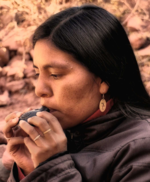| This article possibly contains original research. Please improve it by verifying the claims made and adding inline citations. Statements consisting only of original research should be removed. (October 2020) (Learn how and when to remove this message) |
| The neutrality of this article is disputed. Relevant discussion may be found on the talk page. Please do not remove this message until conditions to do so are met. (November 2022) (Learn how and when to remove this message) |
Black hair is the darkest and most common of all human hair colors globally, due to large populations with this trait. This hair type contains a much more dense quantity of eumelanin pigmentation in comparison to other hair colors, such as brown, blonde and red. In English, various types of black hair are sometimes described as soft-black, raven black, or jet-black. The range of skin colors associated with black hair is vast, ranging from the palest of light skin tones to dark skin. Black-haired humans can have dark or light eyes, but more commonly dark.
Distribution
Black hair is the most common in Asia and Africa. Though this characteristic can also be seen throughout Europe as well, it is considerably less common. It can be found in Celtic populations such as in Ireland, Scotland and Wales. Black hair can come in a variety of textures, just as any hair color. Generally, the East Asian, Central Asian and Native American population has straight hair with a very thick cuticle layer and South Asians have thick, wavy or curly hair, while the general hair type seen in black African hair is thick, curly and dense with more hair growing from the head. The curly quality comes from the shape of the hair follicle, as straight hair grows from more circular hair follicles, and curly hair grows from more oval-like follicles.
Varieties of black hair
- raven black
Naturally, hair reflects light, which is why even black hair does not appear fully dark in the light. However, the darkest shade of black hair, raven-black, does not behave as normal hair would in the light. The name of the color comes from a raven’s wing due to similarities in behavior. Appearing as being almost blue in some conditions, this hair color is mostly found with people from Africa, South and Southeast Asia, Central Asia and Latin America.
True black hair is similar to a black cat's fur.


- deepest brunette: the darkest brown, which can be a very dark chestnut; sometimes appears to be off-black at a distance, and is often considered to be black.
Genetics
Native Americans, East Asian, Southeast Asian, Far East Russian, South Asian, Central Asian and Himalayan black-haired people have thicker hair due to the derived EDAR gene allele that is linked to thicker and potentially straighter hair in some parts of Asia, and shovel-shaped incisors. The derived EDAR gene arose approximately 30,000 years ago in China. One study shows that Paleo-Indians had both variants of the EDAR gene, the derived G-allele and the ancestral A-allele. When they tested ancient DNA remains found in the Americas of the individuals named USR1, Anzick-1 and Laranjal-6700 the results showed that they carried the ancestral A-allele.
11,000-year-old remains of Cuncaicha and Lauricocha individuals from South America share alleles at the highest rate with present-day Amerindians, indicating that the derived G-allele increased in frequency in parallel with the ancestral A-allele.
One of the most studied genes that produce brown hair is MC1R, which helps the body to produce the melanocortin protein. This protein in turn helps the body's hair follicles to produce the type of melanin called eumelanin. To have black hair, one must have genetically inherited this gene from both of their parents, and brown hair is achieved when it is inherited from one parent. This gene is demographically common, as 90% of the total world population carries this gene. Black hair, along with brown hair, comes to turn grey in old age as the hair follicles can no longer produce the pigmentation, but the cause of this inability has yet to be determined.
Gallery
-
 Chinese girl with black hair.
Chinese girl with black hair.
-
 Native American with black hair from South America.
Native American with black hair from South America.
-
 Native American with black hair from North America.
Native American with black hair from North America.
-
 Native American with black hair from South America.
Native American with black hair from South America.
-
 Chinese-Indonesian man with black hair from behind.
Chinese-Indonesian man with black hair from behind.
See also
References
- "Is hair color determined by genetics?: MedlinePlus Genetics". medlineplus.gov. Retrieved 2022-11-17.
- Goodley, Alvin (2019-10-18). "4 Rarest Hair Colors in the World". Archived from the original on 2020-08-06.
- The Distribution of Anthropological Traits in Europe, Bertil Lundman: The Races and Peoples of Europe (New York 1977)
- Hornbeck, Shirley Elro (2000-01-01). This and that Genealogy Tips. Genealogical Publishing Com. ISBN 9780806350271.
- Leerunyakul, Kanchana; Suchonwanit, Poonkiat (April 2020). "Asian Hair: A Review of Structures, Properties, and Distinctive Disorders". Clinical, Cosmetic and Investigational Dermatology. 13: 309–318. doi:10.2147/CCID.S247390. ISSN 1178-7015. PMC 7187942. PMID 32425573.
- Mettrie, Roland (October 2007). "Shape Variability and Classification of Human Hair: A Worldwide Approach". Human Biology. 79 (3): 265–281. doi:10.1353/hub.2007.0045. PMID 18078200. S2CID 39460005.
- "Why do people of African descent have a unique hair texture?". The Tech Interactive. 2021-12-23. Retrieved 2022-11-17.
- "How Many People in The World Have Black Hair?". 23 July 2019.
- McAfee, Clare. "Hair Color Chart". wiggoddess.com. Archived from the original on 15 August 2012. Retrieved 25 October 2012.
- "Native Americans and Asians carry a version of the EDAR gene that is linked to thicker hair shafts". 23 April 2018.
- Kamberov, Yana G.; Wang, Sijia; Tan, Jingze; Gerbault, Pascale; Wark, Abigail; Tan, Longzhi; Yang, Yajun; Li, Shilin; Tang, Kun; Chen, Hua; Powell, Adam (2013-02-14). "Modeling recent human evolution in mice by expression of a selected EDAR variant". Cell. 152 (4): 691–702. doi:10.1016/j.cell.2013.01.016. ISSN 0092-8674. PMC 3575602. PMID 23415220.
- Hlusko, Leslea J.; Carlson, Joshua P.; Chaplin, George; Elias, Scott A.; Hoffecker, John F.; Huffman, Michaela; Jablonski, Nina G.; Monson, Tesla A.; O’Rourke, Dennis H.; Pilloud, Marin A.; Scott, G. Richard (2018-05-08). "Environmental selection during the last ice age on the mother-to-infant transmission of vitamin D and fatty acids through breast milk". Proceedings of the National Academy of Sciences of the United States of America. 115 (19): E4426 – E4432. Bibcode:2018PNAS..115E4426H. doi:10.1073/pnas.1711788115. ISSN 0027-8424. PMC 5948952. PMID 29686092.
- Posth, C.; et al. (2018). "Reconstructing the Deep Population History of Central and South America". Cell. 175 (5): 1185–1197.e22. doi:10.1016/j.cell.2018.10.027. PMC 6327247. PMID 30415837.
- "Is hair color determined by genetics?: MedlinePlus Genetics". medlineplus.gov. Retrieved 2022-11-17.
External links
[REDACTED] Media related to Black hair at Wikimedia Commons
| Human hair color | |
|---|---|
| Hair color | |
| Hair coloring | |
| Other | |